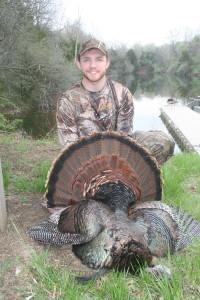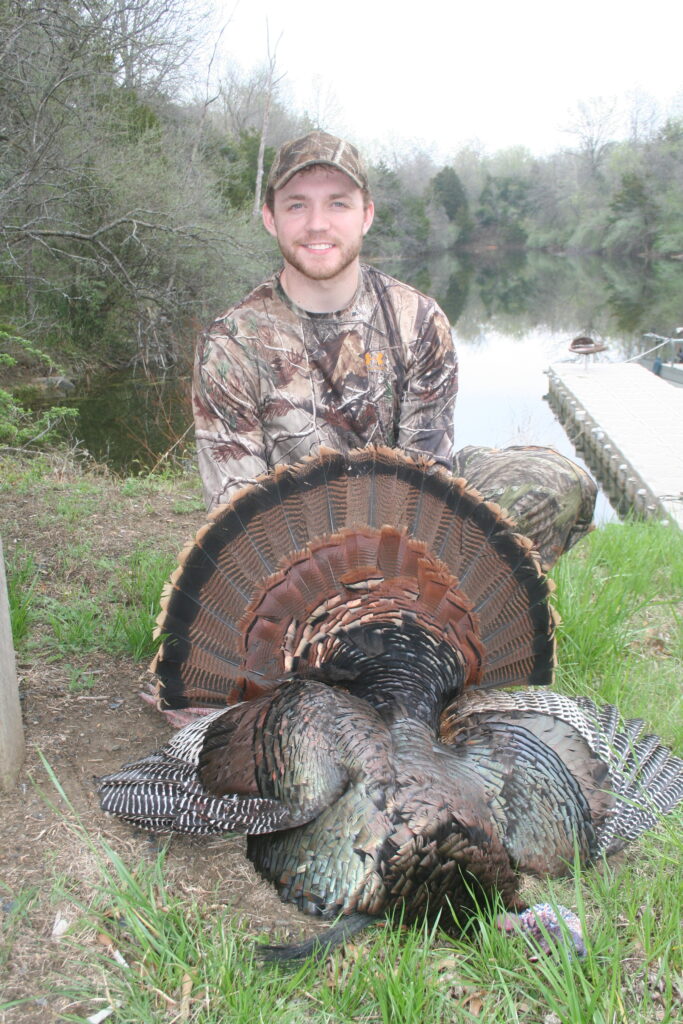On opening day of the spring 2014 Missouri turkey season, I killed one of my largest gobblers to date. It was also one of the latest gobblers I’ve ever taken, having shot him at 12:30pm. I am quite content sitting in a blind and waiting for turkeys to come to me; it’s an extremely successful way to hunt. But I spent a majority of this year’s opening morning running and gunning and quite frankly, you just can’t beat that kind of excitement.
The morning hunt got me thinking about the way other hunters pursue turkeys and it hit me that many of us don’t like to wait. We run and gun, trying to get up close and personal with a gobbling tom rather than remaining patient. While it is aggressive and can educate birds, this tactic can prove to have a high success rate as well. So I’ve decided to compile some relevant advice to help all you runners and gunners out there to bag your birds on a consistent basis.
Scouting
The best thing you can do for yourself as a runner and gunner is complete your due diligence. As with deer, it is vital to scout your turkey hunting area. Spend several mornings listening for gobbles anywhere between 6 AM and noon. Do the same in the afternoon if your state allows hunting all day. This will help you determine where they are roosting, where they go when they come off the roost, and what strutting areas they like.
Once you know this information, you know the exact places you need to go and when you need to be there to potentially strike up a gobbler. It’s a lot better to make your way to an area you’ve seen or heard them in than to just start wandering the woods calling.
While it might be tempting before season to yelp and see where the turkeys are at, try your best not to. You could very easily call one in and then not be able to do anything about it except get busted. There is a steep learning curve when it comes to survival, and turkeys can get an education real fast when it comes to danger.
Closing the Distance
Now we’re talking about the day of the hunt. You’ve just struck up a gobbler a couple hundred yards away, or so it seems. What do you do? How close do you try and get before sitting down and waiting? There are tons of variables that go into this.
First, how windy is it? A lot of wind can cover up both your movement and the sound of your movement, thus allowing you to sneak in closer than you otherwise might normally be able to do. However, it can also make it seem like gobblers are closer in or farther away, or maybe in slightly different directions than they really are. So you must remain vigilant on your entire stalk. Turkeys always seem to find a way to be somewhere you least expect them. If you want to get really hardcore, take your boots off and walk in your bare feet to help you drastically decrease the sound of your steps.
Secondly, as you hustle to get close for a setup, be sure to use your surroundings to your advantage. If a dry creek bed will take you in the direction of your turkey, don’t pass that opportunity up to get below his line of sight. Creek beds and small rises in timbered forests or fields make for great terrain to conceal your movement and make an ambush. Heavy brush can be helpful too, but don’t setup in a way that it will prevent you from being able to shoot. I made that mistake on opening day with one bird. A big no-no is sky lining yourself on top of a ridge. Do not do this. Stay on one side of it and you can easily work over it at a low point or use it to ambush a tom.
Thirdly, if it has recently rained enough to mat down the leaves, then it is the perfect time for you to push the limits to get in closer than you normally would. Wet ground makes it easy to stay quiet on your pursuit. Unfortunately, if you have to crawl you will be feeling pretty miserable in your soaked clothes afterwards, especially if you don’t end up with the bird…
My last piece of advice on closing the distance is unique to each bird. If you’ve got a tom gobbling at every call you make, then you probably should refrain from trying to sneak in too close on him as he probably will come to you. Call excitedly, then quit calling for about five minutes and call again. He won’t be able to stand it having to wait for the hen and he’ll probably gobble again instantly, and maybe even much closer. If you’re dealing with a gobbler that only answers occasionally, be more aggressive and close the distance. Call the entire way and listen closely. Having a hen come to him just might entice him enough to come the rest of the way towards you.

Awareness
Some of the absolute biggest mistakes I’ve ever witnessed turkey hunters (including myself) make comes from having a lack of awareness in the woods. The most common one I’ve seen (and made myself) is not realizing how fast you are going as you try to get close to a gobbler. This is the quickest way to spook a tom and I’ve ruined many of my hunts this way.
Additionally, when you are running and gunning and making calls, be ready to set up immediately. A gobbler could sound off at 300 yards or 50. When you get ready to make a cold call, make sure you are always next to a tree or a nice patch of brush that can break your silhouette when you sit down.
It goes without saying, but be watchful of sticks or other obstacles that could get in your way as you stalk through the terrain. Making unnecessary noise could just as easily spook a turkey as your movement. To go along with this, if you wear a vest or carry a backpack, make sure nothing rattles while you are walking.
As you move through the woods, don’t forget to appreciate the awesome scenes you may witness that only the spring can provide. Morel mushrooms might be popping. You might observe a pair of mating box turtles as well. Or, like a recent experience I had, you might sneak up to within feet of a pair of beautiful wood ducks quietly swimming in a small stream through the timber.
General Tips
Always be safe! Don’t run with a loaded gun and be sure to look out for other hunters if you are hunting public ground.
Always keep a pair of prune clippers with you for trimming limbs. Sometimes the perfect setup isn’t there for you, so you have to make it yourself. You’ll want to make sure you will be comfortable so you won’t move around and fidget. Try your best to position yourself in such a way that when you see the gobbler he will already be in range.
Next, be sure to pile up leaves next to your leg so you can use them to imitate a hen scraping in the leaves. This is one of the oldest tricks in the book to entice a tom into taking those final steps to his grave.
I can’t emphasize this one enough. Learn to use a mouth call. It takes practice and you will have to invest time in it, but it is hands down one of the best things you can do. It’s fairly difficult to use a slate or box call when you are trying to ready yourself for an approaching gobbler. Having a mouth call makes that easier and helps you make less movement.
Lastly, my favorite time to run and gun is after 9:30 in the morning, when gobblers have usually finished with hens and started roaming looking for another mate. This roaming period is when they like to start gobbling again and become aggressive in pursuing new hens. I’m only 22, but I’ve killed roughly 30 birds in my life now. One thing I’ve seen consistently, especially in Missouri, is that a gobbling tom after 9:30 AM is usually a killable one.
Liked this story? Subscribe here for more updates!


